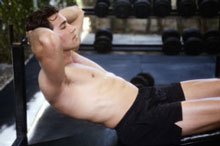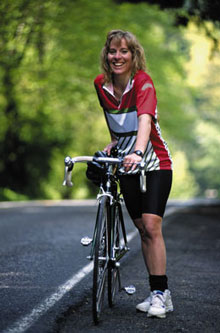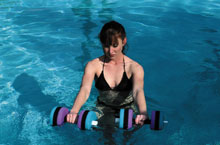



By JoAnn Guidry
Okay, this is it. This is the year that you decide you are going to do it. No more excuses. No more procrastination. Just do it.
The ‘it’ we’re talking about is exercise. For some people, it might as well be a four-letter word. It is the enemy for sure. Exercising means you’re not doing something else you’d rather be doing instead. Like lying on the couch, watching TV. At the computer, surfing the Internet. And the big one, the best one — eating.
But you’ve read the articles, seen and heard the statistics. We have become a nation of overweight, under-exercised people. In the land of plenty, we don’t have one of the most important things in life — our health.
In a recently released survey by the Centers for Disease Control and Prevention, it was reported that 55 percent of adults in the United States don’t achieve the recommended standard 30 minutes of moderate exercise five days a week. The most active state was Wyoming (55.8 %) and the least active was Kentucky (28.9%). Florida came in with 45.5 percent, meaning 54.5 percent of the state’s adult population isn’t getting enough exercise.
Now that you’re motivated, where to go from here? Just exactly what kind of exercise are you going to do? There are a lot of choices out there, a lot of information to sort through. What to do. Where to do it. When to do it. How often to do it.
It’s enough to send a person running back to the couch!
But according to Dr. Patrick Bird, a professor of exercise and sports science at the University of Florida, it’s really not all that complicated — and never has been. Dr. Bird can succinctly sum up the whole quandary of exercise into one word: Move!
“Despite all the research, all the studies, all the fad exercise routines,” explains Dr. Bird, “the basic advice hasn’t changed over the years. You have to move your body to get and stay in shape. It’s that simple.”
What Dr. Bird defines as “getting in shape” is developing your cardiovascular fitness, as well as your strength and flexibility. He adds that this also means improving your body composition by increasing or maintaining muscle mass and bone strength, and losing weight when appropriate.
You’re tired already, aren’t you? Hang on to your resolve just a little longer.
“A brisk walk, at more than just a stroll, for thirty minutes a day is good,” says Dr. Bird. “It’s most certainly better than doing nothing.”
And there’s evidence that everyday activities such as gardening, taking the dog for a walk, using stairs instead of the elevator, parking at the far end of the mall lot and walking in, vacuuming, and mowing the lawn are viable forms of exercise. Oh, and that’s mowing the lawn with an old-fashioned push mower.
Bird cited two recent studies noted in the Journal of the American Medical Association that compared the effects of “lifestyle” activities and “traditional” exercise. The subjects were 116 sedentary men and 119 sedentary women, ages 35-60, randomly divided into two groups. One group logged 30 minutes a day of “lifestyle” activities such as the aforementioned dog walking and yard work. The other group participated in “traditional” aerobic exercise in a gym, putting in 20-60 minutes three to five days a week on equipment such as treadmills and stationary bikes.
“At the end of the 24-month period of the study, both groups produced significant and comparable improvement in health and fitness,” Dr. Bird reveals. “These studies offer some encouragement that accumulating a half hour of moderate physical activity of any kind three or more days a week can contribute to good health.”
So now you’re thinking this exercising thing won’t be so tough after all. Sure, you can go out and rake some leaves. Carry in the groceries. No problem. You can do this.
But there is a problem, according to Dr. Bird. “You have to do these everyday things every day,” he said. “And you have to do them for at least twenty to thirty minutes at a time. This is where people run into trouble. Walking up the stairs or mowing the lawn once a week won’t get you the results that you want.”
That’s why Dr. Bird, who is all for an active lifestyle, believes scheduling time for exercise is a more reliable way to get in shape.
“We are creatures of habit and setting up a time and a place to exercise, making it a habit is very important,” he said. “Even on days when you don’t feel like exercising, if you just show up on time at the place, next thing you know, you’re exercising.”
All right, you’ve decided to show up. Now what do you do?
Dr. Bird recommends a basic exercise routine that incorporates aerobics and strength training, 20-60 minutes a day at least three days a week. An advanced routine would be 45-60 minutes five days a week. Good aerobic exercises are walking, hiking, jogging, cycling, dance, stair climbing, and swimming. Strength conditioning exercises include push-ups, sit-ups, stretching, and using weight machines.
The latter is just what Dr. Bird suggests, especially for the strength training aspect of the exercise routine. “A good gym offers supervision and state-of-the-art machines,” says Dr. Bird. “This is very important because weight machines are designed to exercise a specific muscle group, the weight can be changed easily, and you can complete a workout quickly. Also a trainer can set up a program for you and monitor your progress.”
Another benefit of going to a gym is that it offers a set place to go to exercise and it provides a social setting. “For some people, a social setting is a prime motivator,” says Dr. Bird. “You’ve got a trainer and/or your exercise buddies waiting on you.”
Now that Dr. Bird has convinced you to get moving, he’s also going to tell you that rest is also an important part of an exercise routine. Rest? Now this is the part you’ll like.
“Exercise causes microscopic damage to your muscles,” says Dr. Bird. “This is a normal consequence of exercise and it takes about 24 hours of rest for the tissue to heal. That’s why rest is required both to repair the body and reap the rewards of exercise.”
This recovery period is the reason for the three-workouts-a-week recommendation, but there is a way to safely exercise more frequently. One is by cross-training, alternating your aerobic and strength training days. Also vary the intensity of your workouts from day to day. Avoid more than two hard workout days in a row.
This is all great advice, but you’re wondering if Dr. Bird practices what he preaches. Indeed he does.
For the past 25 years, Dr. Bird has followed an exercise regime that includes swimming three days a week for 45 minutes and strength training for 45 minutes on two days. In addition, he’s an avid walker and cyclist. By the way, Dr. Bird is 67 years old.
Some last bit of advice from Dr. Bird: If you haven’t had a physical checkup in awhile, it’s probably a good idea to get one before you start an exercise program. To avoid injury, start an exercise routine slowly, build up gradually, limit each exercise session to a maximum of 60 minutes, add variety to your routine, and don’t overdo it.
So what are you waiting for? Kiss that couch goodbye. Get out there and exercise!
JoAnn Guidry is the author of the novel “Cowboy Heart.” When she isn’t writing about the Florida Thoroughbred industry, she’s out riding on the Florida Greenway trails. She can be reached at joann@ocalastyle.com






